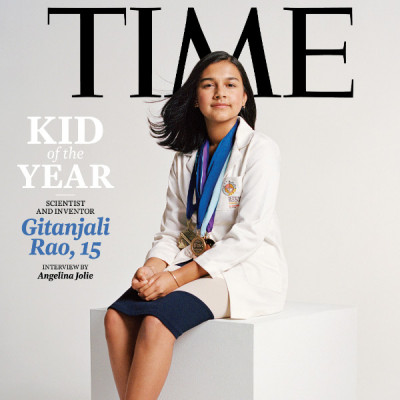
2020-12-09
Visited : 2129
A 15-year-old American scientist and inventor has been named as TIME magazine's first 'Kid of the Year'.
Gitanjali Rao has had a passion for science since she discovered carbon nanotube technology, a method which uses molecules to pick up chemicals in water, and she hasn't slowed down since then.
In 2017 she was named on the Forbes '30 Under 30' list for discovering developing a device that can detect lead in drinking water, inspired by the water crisis in Flint, Michigan.
Her latest project is an anti-cyberbullying app called Kindly that discovers incidents at early stages using artificial intelligence.
Rao was picked out of a group consisting of 5,000 nominees, but wowed the judges with her application of technology to combat social and environmental issues.
In an interview with Angelina Jolie for the magazine, the Colorado-based youngster said: "I don't look like your typical scientist.
"Everything I see on TV is that it's an older, usually white man as a scientist.
"It's weird to me that it was almost like people had assigned roles, regarding like their gender, their age, the color of their skin.
"My goal has really shifted not only from creating my own devices to solve the world's problems, but inspiring others to do the same as well.
"Because, from personal experience, it's not easy when you don't see anyone else like you.
"So I really want to put out that message: If I can do it, you can do it, and anyone can do it."
Rao is a student at the STEM School Highland Ranch and has given three TEDx talks in her short life so far. She's also received the US Environmental Protection Agency President's Environmental Youth Award.
Rao hopes to attend the Massachusetts Institute of Technology (MIT) to study genetics and epidemiology.
Her greatest achievement to date is a device named Tethys that allows for the safety of water to be tested easily and wherever necessary.
It consists of a core, a processor with a Bluetooth extension, a nine-volt battery, and a disposable lead cartridge.
The device can then be connected easily to any smartphone.
When the sensor - which is a carbon nanotube - touches the water, it begins to analyse the chemical reactions and gives a reading on whether the water is safe to drink.
In 2017, Rao told Denver Post: "All you have to do is connect over Bluetooth and your phone,"Then you open up the app, which I also developed, to get the status of 'safe,' 'slightly contaminated' or 'critical.' It takes about 10 seconds to get a reading."
Read the original article on LADbible.